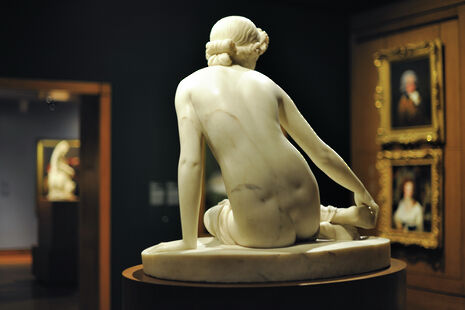The Art of Art: in defence of beauty
From Duchamp to Dostoyevsky, Bea Hannay-Young explores our notion of beauty in this week’s column

The prize for longest on-off love affair should be awarded to beauty and the human race. It was fashionable with the impressionists, in the 18th century (the ‘aesthetic’ era), and in the marble abs of the classical Olympians. The current consensus is that beauty and art are ‘on a break’.
In our recent and post-modern past, beauty has acquired a pariah status from artists and critics alike – when Duchamp (of urinal fame) was told his ready-mades were beautiful, “nobody’s perfect” was his reply. Beauty seems to us a bit too easy, a little simple, a tad unsophisticated. Our relationship with beauty is both peculiar and tragic: from the earliest shell beads to our Instagram dedication, we have historically sought to live in and around things that are beautiful.
Inherent to this conflict, I think, is our notion of beauty itself. I think we can largely define beauty as something that induces some sort of pleasure in its audience. For the most part, this has placed beauty into a false dichotomy with critical and political engagement.
Sometimes art is designed to make us uncomfortable, it’s ugly on purpose – the critic Arthur Danto coined this as “Kalliphobia”. It can seem superficial to want to look at pretty things when art has the potential to challenge our comfort zones and make us consider truths that are unpleasant.
If art has to be zeitgeist-y, then any notion of beauty we present at the moment is going to be ironic. We relate beauty to goodness, and that’s something for the most part we consider ourselves to be incapable of: we see the world as an ugly place.
“To write poetry after Auschwitz is barbaric,” was the cynical conclusion of Theodor Adorno. I respectfully disagree – it is exactly because of horrible things that beautiful art is so necessary. We shouldn’t be so quick to discredit philosophy as either an artistic or philosophical notion – and it’s patronising of the critic to assume that in loving and wanting beauty we are wilfully ignorant of all the terrible things in the world.
We’ve been subjected to the horror of both Brexit and the 2016 US presidential election in the space of six months. Refugees are displaced, bees are dying, and Adam Sandler keeps making movies. I need a little beauty in my life right now.
We’re suffering from a dangerous conflation of beauty and perfection, in both the moral and physical sense. It’s an unhealthy mistake to make, forcing us to idealise an unobtainable, homogeneous, and bourgeois ideal. “Beauty as perfection” is what pushes us towards the new iPhone, the photoshopped body, and the plumped-up lips. We need beauty, not beauties. If this is what we’re seeking when we look for aesthetic satisfaction, then we’ll be leaving ourselves perpetually dissatisfied.
Art is valuable exactly because it can teach us to see beauty – though perhaps a more appropriate word would be merit – in things that we’d normally ignore or even disparage, and that’s a very useful perspective when we are constantly saturated with images and ideas that tell us that “everything is awful” and “we are not good enough”. It’s for this reason that Manet’s Bunch of Asparagus is probably my favourite painting. It’s just a vegetable, sure, but it’s portrayed as something monumental. It makes me feel a little hopeful, a little more appreciative of the ordinary.
The Ancient Greeks were more liberal with their conception of the beautiful: their concept of beauty was broader than ours, accepting beautiful forms and compositions as well as beautiful thoughts, words and ideas.
It was a wider and less prescriptive virtue. After this tradition, perhaps we can learn to see beauty as whatever has the capacity to move us, which is exactly why political-critical or even ‘disturbing’ art can at least in theory retain an ability to inspire – consider Picasso’s Guernica. It’s deeply troubling, but still soulful, clever, and therefore beautiful. By this measure, a work denoting a beautiful subject does not also have to be inherently beautiful: soulless designer billboards would be one such example.
True beauty is not frivolous – Dostoyevsky was spot-on when he declared “beauty can save the world”. It goes beyond teaching us to appreciate the wonder of ordinary things; it provides us with a vision of how life can and should look. It’s why beauty and hope are intrinsically related. There’s no shame in being a bit uplifted by a Monet or a Cézanne (or any other image, sound, or experience which moves us), and we can still enrich our lives with these wonderful things while rejecting the phony and the ignorant.
We shouldn't dismiss beauty – and we’re doing ourselves a great disservice if we continue to do so. We just need to think a bit more critically and intuitively about what beauty might mean, and how best to apply it to our own lives
 News / Uni Scout and Guide Club affirms trans inclusion 12 December 2025
News / Uni Scout and Guide Club affirms trans inclusion 12 December 2025 News / Cambridge Vet School gets lifeline year to stay accredited28 November 2025
News / Cambridge Vet School gets lifeline year to stay accredited28 November 2025 News / Cambridge study finds students learn better with notes than AI13 December 2025
News / Cambridge study finds students learn better with notes than AI13 December 2025 Science / Did your ex trip on King’s Parade? The science behind the ‘ick’12 December 2025
Science / Did your ex trip on King’s Parade? The science behind the ‘ick’12 December 2025 News / Pembroke to convert listed office building into accom9 December 2025
News / Pembroke to convert listed office building into accom9 December 2025







